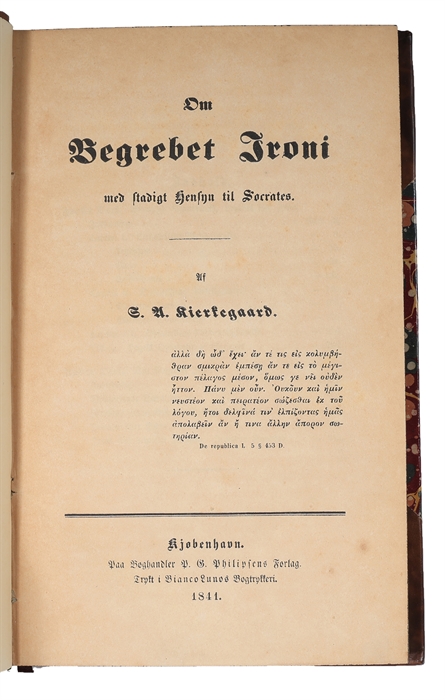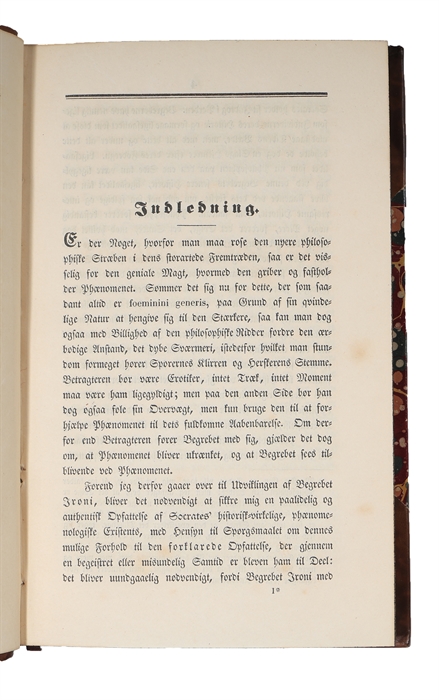KIERKEGAARD'S DISSERTATION
KIERKEGAARD, S(ØREN) A(ABYE).
Om Begrebet Ironi med stadigt Hensyn til Sokrates.
Kjøbenhavn, P.G. Philipsen, 1841.
8vo. Elegant later (ca. 1920) brown half calf with four raised bands and gilt morocco title-label to gilt spine. With Paul Rubow's ownership signature to front free end-paper. Clean and fresh both in- and externally, with no signs of wear to the exterior and only faint brown spots to a few pages. (4), 350 pp.
First edition of Kierkegaard's dissertation, as it appeared in the normal trade, without the preliminary Theses, which were intended for academics attending the defence. Kierkegaard’s dissertation constitutes the culmination of three years’ intensive studies of Socrates and “the true point of departure for Kierkegaard’s authorship” (Brandes). The work is of the utmost importance in Kierkegaard’s production, not only as his first academic treatise, but also because he here introduces several themes that will be addressed in his later works. Among these we find the question of defining the subject of cognition and self-knowledge of the subject. The maxim of “know thyself” will be a constant throughout his oeuvre, as is the theory of knowledge acquisition that he deals with here. The dissertation is also noteworthy in referencing many of Hegel’s theses in a not negative context, something that Kierkegaard himself would later note with disappointment and characterize as an early, uncritical use of Hegel. Another noteworthy feature is the fact that the thesis is written in Danish, which was unheard of at the time. Kierkegaard felt that Danish was a more suitable language for the thesis and had to petition the King in order to gain permission to submit it in Danish rather than Latin. This in itself contains as certain irony, as the young Kierkegaard was known to express himself poorly and very long-winded in written Danish. Both stylistically and thematically, Kierkegaard’s dissertation is a seedbed of his subsequent work and especially a clear precursor for his magnum opus Either-Or that is to be his next publication. The year 1841 is a momentous one in Kierkegaard’s life. It is the year that he completes his dissertation and commences his sojourn in Berlin, but it is also the defining year in his personal life, namely the year that he breaks off his engagement with Regine Olsen. And finally, it is the year that he begins writing Either-Or In many ways, Either-Or is born directly out of “The Concept of Irony” and is the work that brings the theory of Irony to life. Part One of the dissertation concentrates on Socrates as interpreted by Xenophon, Plato, and Aristophanes, with a word on Hegel and Hegelian categories. Part Two is a more synoptic discussion of the concept of irony in Kierkegaard’s categories, with examples from other philosophers. The work constitutes Kierkegaard’s attempt at understanding the role of irony in disrupting society, and with Socrates understood through Kierkegaard, we witness a whole new way of interpreting the world open before us. Wisdom is not necessarily fixed, and we ought to use Socratic ignorance to approach the world without the inherited bias of our cultures. Kierkegaard's dissertation appeared in two states – one with the four pages of “Theses”, for academics of the university, whereas the copies without the theses were intended for ordinary sale. These sales copies also do not have “Udgivet for Magistergraden” and “theologisk Candidat” on the title-page. Himmelstrup 8.
Order-nr.: 61204



